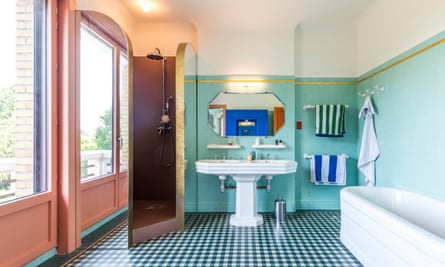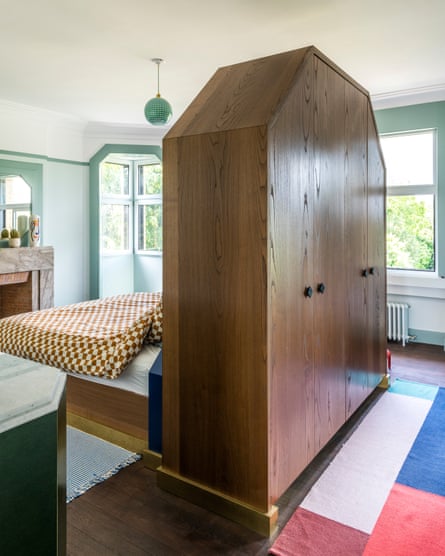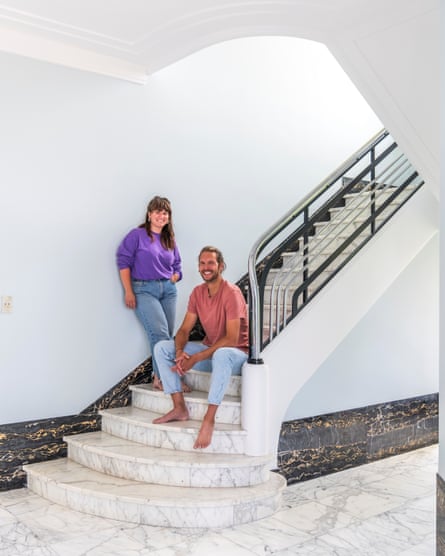
We weren’t aware that an offer had already been made on the property,” says graphic designer and Lille native Tiphaine Richards as she tells me about her family’s home. “When we pulled up outside I was so impressed by the grandeur that I had to see it.” They proceeded with the viewing even though the estate agent had called to cancel their appointment. It clearly hadn’t been inhabited for years, but the grand art deco house was so stunning they could overlook the significant amount of mould they saw growing on the wall when they stepped inside. Tiphaine and Cedric da Rocha instead appreciated the luxury black and gold Portoro marble and extravagant design flourishes in the entrance. “It wasn’t what we were expecting at all, because you usually find big entrances like this in hotels,” Cedric says.
The wide staircase is marble with a chrome railing, which adds to the elaborate design. The detail that had gone into the planning was still evident despite the state of disrepair. “All the original features were still there, including the ceiling lights in most places,” says Tiphaine. When they eventually ended up being able to buy the place, she set to work tracking down sympathetic additions, like the made-to-measure light fittings. “The electrician put in some plastic switches at first and they looked so ugly we had to get some made!”
“The bathroom tiles are also from when the house was built 100 years ago,” she adds. “Only the kitchen is relatively new.” This had been remodelled in the 1990s and featured a modern island they decided to keep. “There was a hole in the ceiling from a leak in the upstairs bathroom,” Tiphaine says. “We had to repair it before we could move in and also update the heating and plumbing.”
Tiphaine had discovered Belgian architect Dries Otten long before finding the project. The couple were drawn to his style: “‘His work really stands out. He finds unconventional solutions and does not shy away from bold shapes and colours,” she says. They asked him to create storage space and add colour.
In the hallway Otten created a striking, striped cloakroom, inspired by the shape and material of the metal radiator cover next to it, and craftily integrated a new shower area in the bathroom by installing a mirrored cubicle.

“A lot of research went into this project,” says Tiphaine. “We had to find sinks that were similar to the original and I found ours on an Italian website, Bleu Provence, which are almost identical.” These have been completed with vintage-style taps from Jacob Delafon.
Surprisingly, in a house of this size, there are only three bedrooms – it was originally built for a couple and their maid. In the master bedroom they carried the bevelled-corner design of the original doorways into the shape of the headboard, which doubles as a wardrobe. “These types of corners are typically art deco, but you also see them in the postmodernism of the 1980s,” says Tiphaine.

“I recently bought a cupboard from a vintage shop with exactly the same corners. I’m going to paint it in a bright colour and put it in the living room.” In their son Felix’s room, they’ve integrated bespoke furniture using their own mix of vibrant colours from Théodore paints.
The work included removing plaster from the walls because of the mould and in three of the rooms the parquet flooring was rotten. “We laid the new floors, which we bought from Kalfleche in Lille, ourselves. We oiled the wood, too, which took us about a week,” Tiphaine says.
With 26 windows to replace, things were becoming costly. “I asked for recommendations of local artisans because we wanted the windows to be as close to the original design as possible,” says Cedric. Unfortunately they couldn’t maintain the same opening mechanism as it was too expensive. Once they decided on the units, he made the surrounds himself. “I had to draw the design, buy the wood and make everything bespoke for each window, which took a long time,” he says.
Maintaining the soul and authenticity of the house continues to be a priority, but the family also wants to bring it into the 21st century. “We still need to finish the living room, but I already love spending time upstairs in the bedrooms – which are pretty much done – because there’s lots of light there,” Tiphaine explains. “As the house is square and the hallway is central, it’s easy to circulate around. We can even see one room from the other and so it all feels very warm and inviting to be in.”



